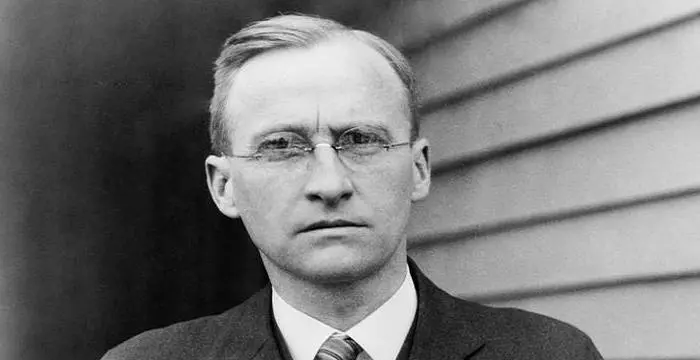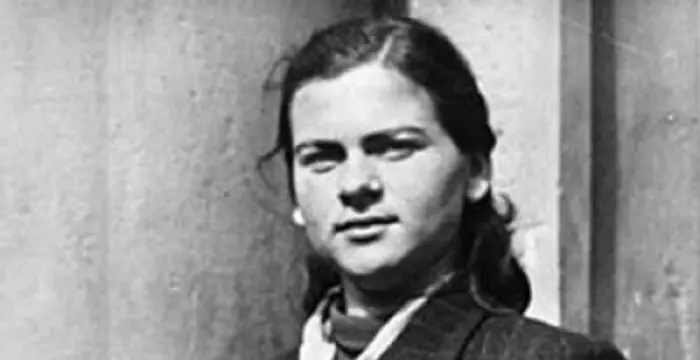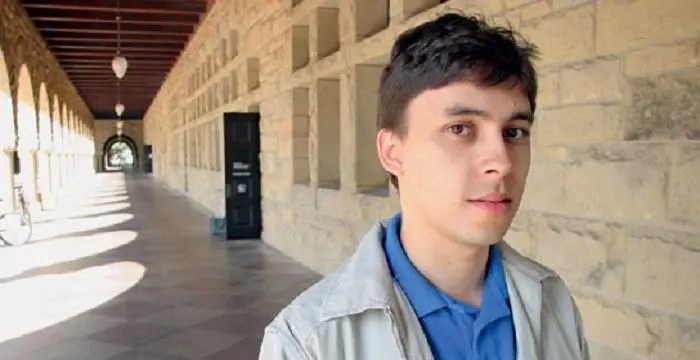
Carl Ludwig Siegel - Scientists, Birthday and Childhood
Carl Ludwig Siegel's Personal Details
Carl Ludwig Siegel is considered to be one of the greatest mathematicians of the 20th century
| Information | Detail |
|---|---|
| Birthday | December 31, 1896 |
| Died on | April 4, 1981 |
| Nationality | German |
| Famous | Scientists, Mathematicians |
| Universities |
|
| Birth Place | Berlin, German Empire |
| Gender | Male |
| Sun Sign | Capricorn |
| Born in | Berlin, German Empire |
| Famous as | Mathematician |
| Died at Age | 84 |
// Famous Mathematicians
Grigori Perelman
Grigori Perelman is a Russian mathematician who is best known for his contributions to Riemannian geometry and geometric topology. Check out this biography to know about his childhood, family life, achievements and fun facts about him.
Terence Tao
Terence Tao is an Australian- American mathematician who has contributed enormously to the field of mathematics. Check out this biography to know about his childhood, family life and achievements.
Isaac Newton
Isaac Newton was an English scientist and mathematician, who discovered gravitation and Newtonian Mechanics. Read this biography to find more on his life.
Who is Carl Ludwig Siegel?
Carl Ludwig Siegel is considered to be one of the greatest mathematicians of the 20th century. Nothing is known about his life prior to his admission at the Humboldt University at the age of nineteen. Although he initially wanted to pursue astronomy, his interest was turned towards number theory under the guidance of his teachers at Humboldt. Later, he wrote his dissertation on Diophantine approximations, earning his doctoral degree from the University of Göttingen, beginning his career at Johann Wolfgang Goethe-Universität of Frankfurt am Main two years later. But even before that, he was able to establish himself as an eminent mathematician with his ‘Thue–Siegel–Roth theorem’. An anti-Nazi and an antimilitarist, he left his homeland at the onset of the Second World War, teaching in the USA from 1940 to 1951. Otherwise, he lived mostly in Germany devoting himself to teaching and mathematical research. Today, he is especially noted for his work on number theory and celestial mechanics. Apart from publishing number of groundbreaking papers on these subjects, he had also written several textbooks on them.
// Famous Scientists
Juliane Koepcke
Juliane Koepcke is a German-Peruvian biologist, who was the lone survivor among the 92 passengers and crew of the ill-fated LANSA Flight 508 that crashed in the Peruvian rainforest on 24 December 1971. Know more about her life in this biography.
Henry Cavendish
Henry Cavendish was a theoretical chemist and physicist, renowned for discovery of hydrogen and calculation of the mass of earth. To know more about his childhood, profile, timeline and career read on
Konstantin Tsiolkovsky
Konstantin Tsiolkovsky was a Russian rocket scientist and a pioneer of astronautics. This biography provides detailed information about his childhood, family, personal life, career, achievements, etc.
Childhood & Early Years
Carl Ludwig Siegel was born on December 31, 1896 in Berlin, Germany. His father, whose name remains unknown, was a postal worker. Nothing else is known about his family background or his early childhood.
Although we know nothing about his schooling, he must have had a thorough education, as we would later find that he could read the works of ancient mathematicians in their original language. He must have also been a good student, entering Humboldt University with astronomy, mathematics and physics in 1915.
In those days, professors at Humboldt University conducted the beginners’ classes themselves. This way, they could pick out the gifted students at the very beginning and direct their career accordingly.
Although Siegel entered the Humboldt University with the intention of studying astronomy, he was soon picked up by theoretical physicist Max Karl Ernst Ludwig Planck and mathematician Ferdinand Georg Frobenius. Very soon, under the influence of Frobenius, Siegel gave up astronomy, becoming more interested in number theory.
In 1917, as the First World War progressed, Siegel was conscripted in the army. An antimilitarist, he could not adjust to the army life. For some time, he was also committed to a psychiatric institute; but nothing could change him. Ultimately, he was discharged from the army.
During his time at the psychiatric institute, Siegel came in contact with Edmund Georg Hermann Landau, a professor of University of Göttingen, working in the fields of number theory and complex analysis. Siegel had later said that he could withstand his experience at the institute only because of Landau.
After being discharged, Siegel did not return to Humboldt University. In 1919, he joined Georg-August University of Göttingen as teaching and research assistant under Edmund Landau. Working under Landau’s guidance, he wrote his dissertation on Diophantine approximations.
In 1920, he received his doctoral degree. His dissertation was considered “a landmark in the history of Diophantine approximations”. Thereafter, he remained with the University of Göttingen, working on various topics, also publishing many groundbreaking papers.
Carl Ludwig Siegel’s work on Roth’s theorem, undertaken in 1921, is one of his major achievements of this period. It established him as an eminent mathematician. Therefore, when in 1922, Arthur Moritz Schönflies, retired from his post at Johann Wolfgang Goethe-Universität of Frankfurt am Main, Siegel was invited to succeed him.
Early Career
In 1922, Carl Ludwig Siegel moved to Frankfurt am Main, beginning his career as a Professor of Mathematics at Johann Wolfgang Goethe-Universität. By then, many eminent mathematicians such as Ernst Hellinger, Otto Szász, Paul Epstein and Max Dehn were already employed at the same department, creating a vibrant atmosphere.
Soon after joining his new position Siegel formed a close relationship with his new colleagues, working together without the thought of personal ambition. They would meet every Thursday afternoon, from four o’clock to six o’clock, talking about various matters.
Very soon, Siegel, Hellinger, Epstein, and Dehn began to collaborate on various matters. The seminar on the history of mathematics, started in 1922, was one such event. It continued for thirteen years and in later years, Siegel often looked back at them as the happiest memories of his life.
The participants at the seminar were required to study the works of ancient mathematicians in their original language. Yet, the number of participant was never less than six and together they studied the works of Euclid, Archimedes, Fibonacci, Cardan, Stevin, Viète, Kepler, Desargues, Descartes, Fermat, Huygens, Barrow and Gregory.
Siegel was also a dedicated teacher. In the beginning, he had few students; in the advanced courses there were only two. One day both of them were delayed and reaching late in class, they found that Siegel had already started teaching, having filled up a whole section of the blackboard.
By 1928, he had 143 students attending his differential and integral calculus classes, as a result of which, he had to spend a lot of time correcting their papers. In spite of that, he continued with his research work.
In 1929, he published an important paper concerning linear equations. Known as ‘Siegel’s lemma’, it is pure existence theorem, referring to the bounds on the solutions of the said equations obtained by the construction of auxiliary functions. Also in the same year, he proved ‘Bourget's hypothesis’.
In 1932, Siegel discovered an unpublished manuscript, written in 1850s by Bernhard Riemann. From this work, he derived an asymptotic formula, which later became known as ‘Riemann-Siegel formula’.
Later Career
On 30 January 1933, Hitler came to power in Germany and on 7 April 1933 the Civil Service Law was promulgated, removing Jewish teachers from the universities. Although Siegel was not affected by it, his friend, Otto Szász, was dismissed from service and Siegel found that very much disturbing.
From January 1935 to June 1935, he spent six-month sabbatical leave at the Institute for Advanced Study at Princeton, USA. On his return he found that Epstein, Hellinger and Dehn had been dismissed from their post. Sometime in the same year, he corrected an error in the Smith-Minkowski formula.
In 1936, he went to Oslo, Norway to attend International Congress of Mathematics on the invitation of the International Mathematical Union. It was a great honor for him because being invited to speak at ICM is almost like being inducted into the hall fame.
In 1937, he was invited to join University of Göttingen. Accepting the position towards the end of the year, he moved to Göttingen in early 1938. Here too he found that life, both inside and outside the campus, was highly influenced by Nazi policies.
Disturbed by the political atmosphere Siegel led a somewhat retired life in Göttingen. However, it did not stop him from pursuing his academic interest. In 1939, he started working on what later came to be known as ‘Siegel Modular Form’. In the same year, he also introduced ‘Siegel upper half-space’.
As the Second World War broke out in September 1939, as a result of German invasion of Poland, Siegel felt he could no longer live there. In early 1940, he left for Denmark and from there he went to the USA via Norway.
In the USA, he joined the Institute for Advanced Study at Princeton, working there from September 1940 to June 1945 as a member of mathematics. In September 1946, his professorship was made permanent. However, he was not very happy there, considering his time in the USA as a ‘self-imposed exile’.
In June 1951, on receiving an offer from the University of Göttingen, Siegel resigned from his position at Institute for Advanced Study and returned home. Thereafter for next eight years, he remained with the University of Göttingen, continuing to publish number of groundbreaking papers on mathematics.
In 1959, Siegel retired from University of Göttingen. But, he did not stop working, continuing to publish important papers well into seventies. In the fall of 1960, he also worked for a brief period at Institute for Advanced Study at Princeton.
In 1964, while he was almost seventy years old, he conjectured that e−1/2, or about 60.65%, of all prime numbers are regular, in the asymptotic sense of natural density. This later became known as Siegel’s Conjecture’.
Siegel also enjoyed teaching, not only advanced theory, but also the elementary courses. However, he had few research students working under him mainly because he demanded perfection and thoroughness. Among his students, who later established themselves as great mathematicians, were Kurt Mahler, Christian Pommerenke, Theodor Schneider and Jürgen Moser.
Major Works
Carl Ludwig Siegel is best known for his contributions to the ‘Thue–Siegel–Roth theorem’ in Diophantine approximation. Originally established by Roth, it stated that “a given algebraic number (alpha) may not have too many rational number approximations, that are very good”. In 1921, working closely on the theorem, Siegel refined the meaning of ‘very good’.
Siegel is also known for his contribution to the ‘Smith-Minkowski-Siegel’ formula. In 1935, he found an error in, what was then known as, Smith-Minkowski formula. Working on it, he was able to correct that error. Henceforth, the formula began to be known as ‘Smith-Minkowski-Siegel’ formula.
Awards & Achievements
In 1978, Carl Ludwig Siegel received the first Wolf Prize in Mathematics jointly with Israel Gelfand of Soviet Russia. Siegel was awarded this prestigious prize “for his contributions to the theory of numbers, theory of several complex variables, and celestial mechanics”.
Death & Legacy
Carl Ludwig Siegel never got married, devoting his entire life to mathematics. Even in his old age, his mental power remained unabated and he published number of papers in his seventies. He also went on lecture tours to various countries.
He died on April 4, 1981 in Göttingen, West Germany, at the age of 84.
// Famous Capricorn Celebrities peoples
Weston Koury
All about American social media star Weston Koury, including his age, family life, girlfriends, birthday, and some fun facts.
Elin Nordegren
Elin Nordegren is the ex-wife of Tiger Woods. Check out this biography to know about her childhood, family life, achievements and fun facts about her life.
ItsJustNick
ItsJustNick is a Canadian YouTube star & social media personality. Let’s take a look at his family and personal life including age, date of birth, net worth, girlfriends, and fun facts.
Carl Ludwig Siegel's awards
| Year | Name | Award |
|---|---|---|
Other | ||
| 0 | 1978 - Wolf Prize in Mathematics | |
| 0 | - copey medal | |
Carl Ludwig Siegel biography timelines
- // 31st Dec 1896Carl Ludwig Siegel was born on December 31, 1896 in Berlin, Germany. His father, whose name remains unknown, was a postal worker. Nothing else is known about his family background or his early childhood.
- // 1915Although we know nothing about his schooling, he must have had a thorough education, as we would later find that he could read the works of ancient mathematicians in their original language. He must have also been a good student, entering Humboldt University with astronomy, mathematics and physics in 1915.
- // 1917In 1917, as the First World War progressed, Siegel was conscripted in the army. An antimilitarist, he could not adjust to the army life. For some time, he was also committed to a psychiatric institute; but nothing could change him. Ultimately, he was discharged from the army.
- // 1919After being discharged, Siegel did not return to Humboldt University. In 1919, he joined Georg-August University of Göttingen as teaching and research assistant under Edmund Landau. Working under Landau’s guidance, he wrote his dissertation on Diophantine approximations.
- // 1920In 1920, he received his doctoral degree. His dissertation was considered “a landmark in the history of Diophantine approximations”. Thereafter, he remained with the University of Göttingen, working on various topics, also publishing many groundbreaking papers.
- // 1921Carl Ludwig Siegel is best known for his contributions to the ‘Thue–Siegel–Roth theorem’ in Diophantine approximation. Originally established by Roth, it stated that “a given algebraic number (alpha) may not have too many rational number approximations, that are very good”. In 1921, working closely on the theorem, Siegel refined the meaning of ‘very good’.
- // 1922Carl Ludwig Siegel’s work on Roth’s theorem, undertaken in 1921, is one of his major achievements of this period. It established him as an eminent mathematician. Therefore, when in 1922, Arthur Moritz Schönflies, retired from his post at Johann Wolfgang Goethe-Universität of Frankfurt am Main, Siegel was invited to succeed him.
- // 1922In 1922, Carl Ludwig Siegel moved to Frankfurt am Main, beginning his career as a Professor of Mathematics at Johann Wolfgang Goethe-Universität. By then, many eminent mathematicians such as Ernst Hellinger, Otto Szász, Paul Epstein and Max Dehn were already employed at the same department, creating a vibrant atmosphere.
- // 1922Very soon, Siegel, Hellinger, Epstein, and Dehn began to collaborate on various matters. The seminar on the history of mathematics, started in 1922, was one such event. It continued for thirteen years and in later years, Siegel often looked back at them as the happiest memories of his life.
- // 1928By 1928, he had 143 students attending his differential and integral calculus classes, as a result of which, he had to spend a lot of time correcting their papers. In spite of that, he continued with his research work.
- // 1929In 1929, he published an important paper concerning linear equations. Known as ‘Siegel’s lemma’, it is pure existence theorem, referring to the bounds on the solutions of the said equations obtained by the construction of auxiliary functions. Also in the same year, he proved ‘Bourget's hypothesis’.
- // 1932In 1932, Siegel discovered an unpublished manuscript, written in 1850s by Bernhard Riemann. From this work, he derived an asymptotic formula, which later became known as ‘Riemann-Siegel formula’.
- // 1933On 30 January 1933, Hitler came to power in Germany and on 7 April 1933 the Civil Service Law was promulgated, removing Jewish teachers from the universities. Although Siegel was not affected by it, his friend, Otto Szász, was dismissed from service and Siegel found that very much disturbing.
- // 1935From January 1935 to June 1935, he spent six-month sabbatical leave at the Institute for Advanced Study at Princeton, USA. On his return he found that Epstein, Hellinger and Dehn had been dismissed from their post. Sometime in the same year, he corrected an error in the Smith-Minkowski formula.
- // 1935Siegel is also known for his contribution to the ‘Smith-Minkowski-Siegel’ formula. In 1935, he found an error in, what was then known as, Smith-Minkowski formula. Working on it, he was able to correct that error. Henceforth, the formula began to be known as ‘Smith-Minkowski-Siegel’ formula.
- // 1936In 1936, he went to Oslo, Norway to attend International Congress of Mathematics on the invitation of the International Mathematical Union. It was a great honor for him because being invited to speak at ICM is almost like being inducted into the hall fame.
- // 1937In 1937, he was invited to join University of Göttingen. Accepting the position towards the end of the year, he moved to Göttingen in early 1938. Here too he found that life, both inside and outside the campus, was highly influenced by Nazi policies.
- // 1939Disturbed by the political atmosphere Siegel led a somewhat retired life in Göttingen. However, it did not stop him from pursuing his academic interest. In 1939, he started working on what later came to be known as ‘Siegel Modular Form’. In the same year, he also introduced ‘Siegel upper half-space’.
- // 1940As the Second World War broke out in September 1939, as a result of German invasion of Poland, Siegel felt he could no longer live there. In early 1940, he left for Denmark and from there he went to the USA via Norway.
- // 1940In the USA, he joined the Institute for Advanced Study at Princeton, working there from September 1940 to June 1945 as a member of mathematics. In September 1946, his professorship was made permanent. However, he was not very happy there, considering his time in the USA as a ‘self-imposed exile’.
- // 1951In June 1951, on receiving an offer from the University of Göttingen, Siegel resigned from his position at Institute for Advanced Study and returned home. Thereafter for next eight years, he remained with the University of Göttingen, continuing to publish number of groundbreaking papers on mathematics.
- // 1959In 1959, Siegel retired from University of Göttingen. But, he did not stop working, continuing to publish important papers well into seventies. In the fall of 1960, he also worked for a brief period at Institute for Advanced Study at Princeton.
- // 1964In 1964, while he was almost seventy years old, he conjectured that e−1/2, or about 60.65%, of all prime numbers are regular, in the asymptotic sense of natural density. This later became known as Siegel’s Conjecture’.
- // 1978In 1978, Carl Ludwig Siegel received the first Wolf Prize in Mathematics jointly with Israel Gelfand of Soviet Russia. Siegel was awarded this prestigious prize “for his contributions to the theory of numbers, theory of several complex variables, and celestial mechanics”.
- // 4th Apr 1981He died on April 4, 1981 in Göttingen, West Germany, at the age of 84.
// Famous German peoples
Jordan Carver
Jordan Carver is a famous German model. Let’s take a close look at her personal life, including her age, career, net worth, achievements and some fun facts.
Jürgen Klopp
Jürgen Klopp is a German football manager, and a former professional football player. Check out this biography to know more about his childhood, family, personal life, etc.
Irma Grese
Irma Grese was a notorious German Nazi concentration camp guard during the Second World War. This biography profiles her childhood, life, horrifying acts, death and other facts.
Juliane Koepcke
Juliane Koepcke is a German-Peruvian biologist, who was the lone survivor among the 92 passengers and crew of the ill-fated LANSA Flight 508 that crashed in the Peruvian rainforest on 24 December 1971. Know more about her life in this biography.
Jawed Karim
Jawed Karim is a German-American internet entrepreneur, technologist and co-founder of the video-sharing website, YouTube. Check out this biography to know about his childhood, family, personal life, achievements, age, etc.
Charles Bukowski
Charles Bukowski was a German-born American novelist, short story writer and poet. With this biography, learn in details about his childhood, life, works, career and timeline
Carl Ludwig Siegel's FAQ
What is Carl Ludwig Siegel birthday?
Carl Ludwig Siegel was born at 1896-12-31
When was Carl Ludwig Siegel died?
Carl Ludwig Siegel was died at 1981-04-04
Where was Carl Ludwig Siegel died?
Carl Ludwig Siegel was died in Göttingen, West Germany
Which age was Carl Ludwig Siegel died?
Carl Ludwig Siegel was died at age 84
Where is Carl Ludwig Siegel's birth place?
Carl Ludwig Siegel was born in Berlin, German Empire
What is Carl Ludwig Siegel nationalities?
Carl Ludwig Siegel's nationalities is German
What was Carl Ludwig Siegel universities?
Carl Ludwig Siegel studied at Georg-August University of Göttingen, Humboldt University of Berlin
What is Carl Ludwig Siegel's sun sign?
Carl Ludwig Siegel is Capricorn
How famous is Carl Ludwig Siegel?
Carl Ludwig Siegel is famouse as Mathematician













